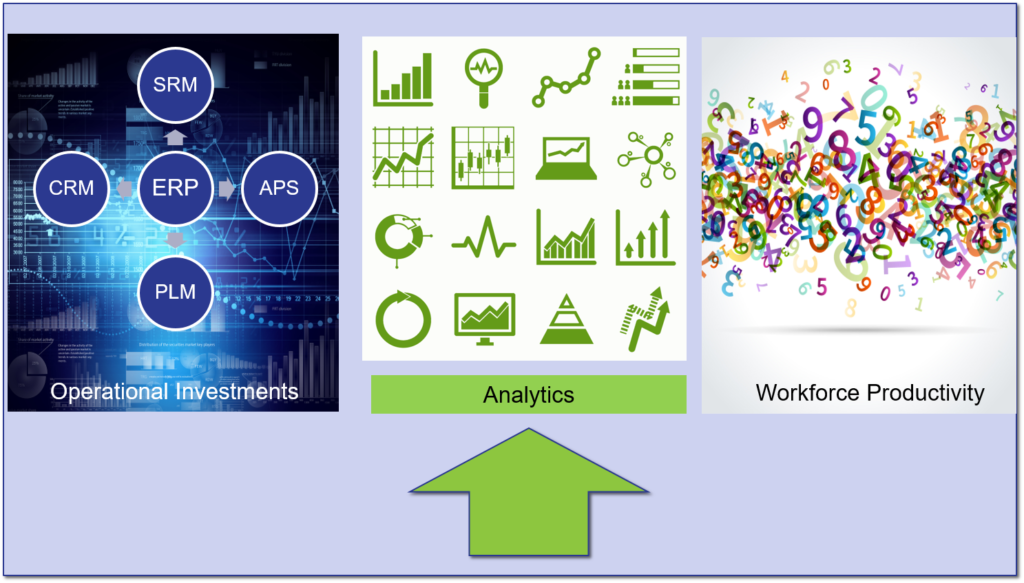 Understanding the new world of supply chain analytics is my current research project. Using unstructured and stream data is a brave new world. The possibilities of data variety and velocity to improve supply chain management excite me. As I study the market, today I have more questions than answers.
Understanding the new world of supply chain analytics is my current research project. Using unstructured and stream data is a brave new world. The possibilities of data variety and velocity to improve supply chain management excite me. As I study the market, today I have more questions than answers.
There is a great need for improved supply chain analytics. New solutions offer great promise. The pace of solution evolution is moving quickly, and it is hard for supply chain leaders to keep up. New names abound. Cloud and open source analytics are fueling new markets giving rise to new software providers in analytics with names like BOARD, Cloudera, Every Angle, Enterra Solutions, FusionOps, Halo, Qlik, Spotfire, TransVoyant, Tamr, Trifacta, and Trufa. There are new capabilities, but how do they fit into supply chain architectures? What is real and what is hype? As I do my research this is my challenge. I am trying to figure it out for the supply chain leader and publish a summary in April for our newsletter.
The Opportunity
The average manufacturing company has over 150 technologies; yet, they cannot get to data. The IT environments are heterogeneous. The analyst views of use of an ERP backbone to drive analytics is quickly eroding. It is just too complex.
When we ask supply chain leaders the simple question, “Is your supply chain working well?” we can see that when they cannot access and use data, it is a characteristic of companies that “are not working well” (reference figure 1). Very few companies feel that they use data well.
Figure 1. Characteristics of Companies with Supply Chains Working Well Versus Those with Room for Improvement

Solution Evolution
In the past decade operational architectures evolved. The first generation of supply chain analytics was an extension of solutions with three-letter acronyms: ERP, CRM, SRM, SCE, and APS. There is now an analytics layer evolving to connect operational technologies with employee productivity tools. As shown in Figure 2, these analytical architectures span structured and unstructured data sources to drive new insights. The automation of processes with these new data forms intrigues me. It is about much, much more than a passive data scientist role. We are seeing the evolution of new processes and analytics to improve insights between operational tools and the workforce productivity investments.
We are also seeing the evolution of streaming-data architectures. While supply chain leaders speak of the need for real-time signals, the supply chain is largely batch. Real-time architectures are evolving. This has great promise for applications using the Internet of Things. It is also applicable for telematics in transportation, manless vehicles and the autonomous supply chain, RFID automation/sensing, weather data, supply chain visibility, and cold chain management.
Figure 2. Evolution of Supply Chain Analytics Architectures

While consultants market big data services, and ERP vendors hawk cloud and new database technologies, open source software is changing the fundamentals. I think that the future for the supply chain leader is not business process outsourcing, the use of data scientists or the extension of ERP.
To move forward, I think that we need to embrace new technologies. I believe that Hadoop is an important enabling technology for streaming data and ingesting large amounts of data in parallel architectures. Apache Hadoop, as shown in Figure 3, may look like a zoo full of animal names. Hadoop, now ten years in its evolution, enables the movement of data, without traditional ETL tools and tight integration, and the building of streaming data architectures. It also enables the use of unstructured data like images, text, social sentiment, and weather.
In the building of supply chain analytics, we are just starting to test and use Hadoop. I believe that the use of open source analytics in combination with new forms of prescriptive and cognitive analytics may make current decision support tools obsolete. We are seeing the redefinition of business analytics. I think in five years supply chain decision support tools will learn continuously. They will sense, act and adapt. Today 8% of companies are testing some form of machine learning.
While only 2% of supply chain leaders today are testing Hadoop, on Tuesday I will co-present on a webinar with Elliott Wolf, director of analytics at Lineage Logistics. Elliott used Hadoop to redesign warehouse processes and layout to maximize warehouse management effectiveness. A simple concept, but his analysis is fascinating. The case study analyzes the velocity of pallets by size and handling types and actively directs put-away to maximize storage. The return on investment was double-digit savings. Listen to hear an amazing case study in the use of Hadoop to solve a traditional business problem.
Figure 3. Hadoop and Big Data Anlaytics Evolution

All I know now is that I have a lot to learn. Like you, I am trying to figure it out. The names of the open source software are as unfamiliar to me now as they probably are to you. However, as I gain new insights, I will be sharing my journey here on the Shaman blog. If you are a supply chain leader testing and trialing Hadoop, I would love to talk to you. I also would love to get your insights by writing your case study and sharing your insights on a podcast.
I will be blogging from the Cloudera conference today and openly sharing insights.
Where Can You Find Out More?

We are currently putting the finishing touches on the Supply Chain Insights Global Summit. (Registration is open for the first 150 participants. Technology provider attendance is limited to 25%.) This agenda will not be the traditional Yada Yada conversation of traditional best practices. Instead, we will continue to push and question the status quo. The conference will be live streamed as we discuss five themes:
- Financial Results. A critical look at supply chain processes impacting supply chain financial results through the Supply Chains to Admire research.
- Economic Vision of Supply Chain 2030. It is hard to know where we are going if we are not clear on the end state. Join us for a critical view of supply chain 2030 through the insights of leading economists.
- New Business Models. Making the Digital Pivot. Sit back and listen as companies share insights on the adoption of robotics, the Internet of Things, 3D printing, manless vehicles, new forms of analytics, and the emergence of new business models like Alibaba, Amazon, and Uber.
- Building Supply Chain Talent and Leadership. Insights on leadership, continuous improvement and talent development for emerging markets.
- Outside-In Processes. Experience the difference between traditional inside-out and outside-in processes.
In addition, you can gain some short-term insights by attending our Network of Networks & Shaman’s Circle in Amelia Island on April 17, 2016 (invitation only), or participating in our new research studies. With the completion of each study we share the research results. We always keep our survey respondents and their responses confidential, but share the results with business leaders in private roundtables to maximize networking.
Our philosophy is, “You give to us, we give to you.” We do this through Open Content research for supply chain leaders. Our current studies in the field are:
 If you are a discrete manufacturer in supply chain, we would love your insights on this research study on direct material sourcing. The goal is to understand how companies manage sourcing in innovation, compare suppliers and collaborate on design. At the conclusion of the research share the results and network with leaders around the world.
If you are a discrete manufacturer in supply chain, we would love your insights on this research study on direct material sourcing. The goal is to understand how companies manage sourcing in innovation, compare suppliers and collaborate on design. At the conclusion of the research share the results and network with leaders around the world.

Agility and flexibility in supply chain operations is strongly dependent on the building of strong cross-functional and horizontal processes of Sales and Operations Planning, revenue management, new product launch and supplier development. In this study, we analyze the maturity of revenue management and Sales and Operations Planning and the value of cloud-based solutions to drive improvements. This study will close in May and the results will be shared with business leaders in a cross-industry round table.
About Lora:
 Lora Cecere is the Founder of Supply Chain Insights. She is trying to redefine the industry analyst model to make it friendlier and more useful for supply chain leaders. Lora has written the books Supply Chain Metrics That Matter and Bricks Matter, and is currently working on her third book, Leadership Matters. She also actively blogs on her Supply Chain Insights website, at the Supply Chain Shaman blog, and for Forbes. When not writing or running her company, Lora is training for a triathlon, taking classes for her DBA degree in research, knitting and quilting for her new granddaughter, and doing tendu (s) and Dégagé (s) to dome her feet for pointe work at the ballet barre. Lora thinks that we are never too old to learn or to push for supply chain excellence.
Lora Cecere is the Founder of Supply Chain Insights. She is trying to redefine the industry analyst model to make it friendlier and more useful for supply chain leaders. Lora has written the books Supply Chain Metrics That Matter and Bricks Matter, and is currently working on her third book, Leadership Matters. She also actively blogs on her Supply Chain Insights website, at the Supply Chain Shaman blog, and for Forbes. When not writing or running her company, Lora is training for a triathlon, taking classes for her DBA degree in research, knitting and quilting for her new granddaughter, and doing tendu (s) and Dégagé (s) to dome her feet for pointe work at the ballet barre. Lora thinks that we are never too old to learn or to push for supply chain excellence.







